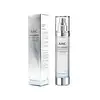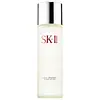What's inside
What's inside
 Key Ingredients
Key Ingredients

 Benefits
Benefits

 Concerns
Concerns

 Ingredients Side-by-side
Ingredients Side-by-side

Water
Skin ConditioningDipropylene Glycol
HumectantPentylene Glycol
Skin ConditioningBifida Ferment Lysate
Skin ConditioningHydroxyethylcellulose
Emulsion StabilisingPropanediol
SolventCarbomer
Emulsion StabilisingPolyglyceryl-10 Laurate
Skin ConditioningTromethamine
BufferingCaprylyl Glycol
EmollientEthylhexylglycerin
Skin ConditioningAllantoin
Skin ConditioningDisodium EDTA
Sodium Hyaluronate
HumectantPanthenol
Skin Conditioning1,2-Hexanediol
Skin ConditioningCitrus Aurantium Bergamia Fruit Oil
MaskingLavandula Angustifolia Oil
MaskingGlyceryl Glucoside
HumectantAnthemis Nobilis Flower Oil
MaskingGlycerin
HumectantTocopherol
AntioxidantGlutathione
Nelumbo Nucifera Flower Water
TonicHyaluronic Acid
HumectantButylene Glycol
HumectantHydrolyzed Hyaluronic Acid
HumectantHydrolyzed Sodium Hyaluronate
Skin ConditioningHydroxypropyltrimonium Hyaluronate
PEG-9 Diglycidyl Ether/Sodium Hyaluronate Crosspolymer
Skin ConditioningPotassium Hyaluronate
Skin ConditioningSodium Acetylated Hyaluronate
HumectantSodium Hyaluronate Crosspolymer
HumectantActinidia Polygama Fruit Extract
Skin ConditioningLactic Acid/Glycolic Acid Copolymer
Skin ConditioningPolyvinyl Alcohol
Hydroxyproline
Skin ConditioningProline
Skin ConditioningAlanine
MaskingLysine
Skin ConditioningSerine
MaskingThreonine
Dimethylsilanol Hyaluronate
HumectantHydrogenated Lecithin
EmulsifyingAscorbic Acid
AntioxidantLinolenic Acid
CleansingWater, Dipropylene Glycol, Pentylene Glycol, Bifida Ferment Lysate, Hydroxyethylcellulose, Propanediol, Carbomer, Polyglyceryl-10 Laurate, Tromethamine, Caprylyl Glycol, Ethylhexylglycerin, Allantoin, Disodium EDTA, Sodium Hyaluronate, Panthenol, 1,2-Hexanediol, Citrus Aurantium Bergamia Fruit Oil, Lavandula Angustifolia Oil, Glyceryl Glucoside, Anthemis Nobilis Flower Oil, Glycerin, Tocopherol, Glutathione, Nelumbo Nucifera Flower Water, Hyaluronic Acid, Butylene Glycol, Hydrolyzed Hyaluronic Acid, Hydrolyzed Sodium Hyaluronate, Hydroxypropyltrimonium Hyaluronate, PEG-9 Diglycidyl Ether/Sodium Hyaluronate Crosspolymer, Potassium Hyaluronate, Sodium Acetylated Hyaluronate, Sodium Hyaluronate Crosspolymer, Actinidia Polygama Fruit Extract, Lactic Acid/Glycolic Acid Copolymer, Polyvinyl Alcohol, Hydroxyproline, Proline, Alanine, Lysine, Serine, Threonine, Dimethylsilanol Hyaluronate, Hydrogenated Lecithin, Ascorbic Acid, Linolenic Acid
 Reviews
Reviews

Ingredients Explained
These ingredients are found in both products.
Ingredients higher up in an ingredient list are typically present in a larger amount.
Butylene Glycol (or BG) is used within cosmetic products for a few different reasons:
Overall, Butylene Glycol is a safe and well-rounded ingredient that works well with other ingredients.
Though this ingredient works well with most skin types, some people with sensitive skin may experience a reaction such as allergic rashes, closed comedones, or itchiness.
Learn more about Butylene GlycolDisodium EDTA plays a role in making products more stable by aiding other preservatives.
It is a chelating agent, meaning it neutralizes metal ions that may be found in a product.
Disodium EDTA is a salt of edetic acid and is found to be safe in cosmetic ingredients.
Learn more about Disodium EDTAGlycerin is already naturally found in your skin. It helps moisturize and protect your skin.
A study from 2016 found glycerin to be more effective as a humectant than AHAs and hyaluronic acid.
As a humectant, it helps the skin stay hydrated by pulling moisture to your skin. The low molecular weight of glycerin allows it to pull moisture into the deeper layers of your skin.
Hydrated skin improves your skin barrier; Your skin barrier helps protect against irritants and bacteria.
Glycerin has also been found to have antimicrobial and antiviral properties. Due to these properties, glycerin is often used in wound and burn treatments.
In cosmetics, glycerin is usually derived from plants such as soybean or palm. However, it can also be sourced from animals, such as tallow or animal fat.
This ingredient is organic, colorless, odorless, and non-toxic.
Glycerin is the name for this ingredient in American English. British English uses Glycerol/Glycerine.
Learn more about GlycerinSodium Hyaluronate is hyaluronic acid's salt form. It is commonly derived from the sodium salt of hyaluronic acid.
Like hyaluronic acid, it is great at holding water and acts as a humectant. This makes it a great skin hydrating ingredient.
Sodium Hyaluronate is naturally occurring in our bodies and is mostly found in eye fluid and joints.
These are some other common types of Hyaluronic Acid:
Learn more about Sodium HyaluronateWater. It's the most common cosmetic ingredient of all. You'll usually see it at the top of ingredient lists, meaning that it makes up the largest part of the product.
So why is it so popular? Water most often acts as a solvent - this means that it helps dissolve other ingredients into the formulation.
You'll also recognize water as that liquid we all need to stay alive. If you see this, drink a glass of water. Stay hydrated!
Learn more about Water